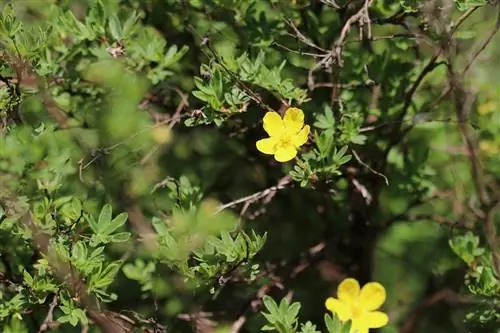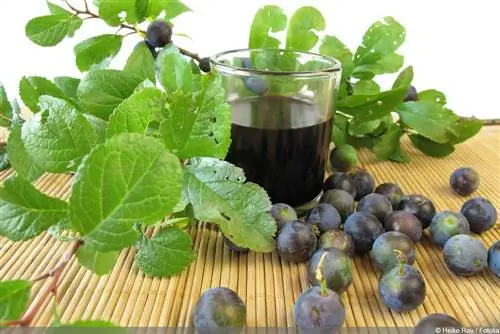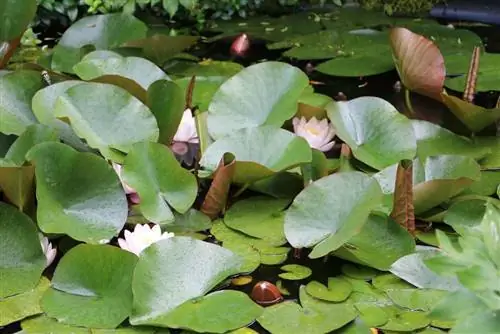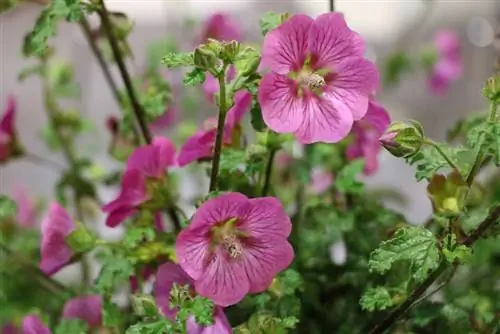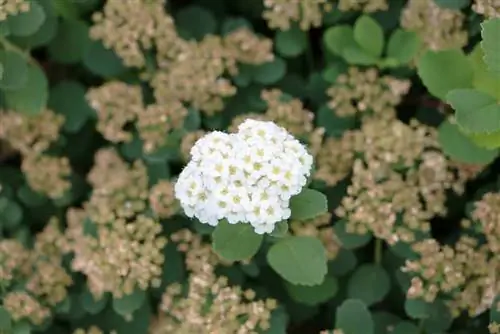- Author admin [email protected].
- Public 2023-12-17 03:39.
- Last modified 2025-01-24 12:45.
The deciduous five-finger bush (Potentilla fruticosa) was long counted in the genus of crab herbs (Potentilla), but today the finger bush from the rose family (Rosaceae) finds its botanical affiliation in the genus Dasiphora (Dasiphora fruticosa). However, the five-fingered bush is still popular as an ornamental tree in gardens and parks, and it is still a robust, continuous bloomer with its small, cup-shaped flowers.
Growth & Flowering
The five-fingered bush (Potentilla fruticosa), whose five-pinnate leaves are reminiscent of the five fingers of a hand, reaches a height of approx.40 cm, with some varieties reaching heights of up to 150 cm. A few species have 3 to 7-fold leaves, but they are all very hairy on the underside. The compactly growing bush displays its numerous small flowers from June to October, with some species blooming as early as May. The perennial bloomer is available in many and very intense colors, with its exclusive, partly double white, yellow, orange, red or pink flowers always providing a magical contrast to the fresh foliage of the wood-forming shrub. The variety Potentilla fruticosa “Orange Shimmer” changes its color from a bright yellow to a shimmering orange at the end of the flowering period.
Substrate & Soil
The five-finger bush prefers sunny and moist locations. Undemanding in care and undemanding to its environment, the five-fingered bush thrives in almost all soils that provide a minimum of nutrients. It thrives in normal garden soil, but Potentilla fruticosa also thrives in poor soils and rock gardens. The flowering plant is particularly suited to a nutrient-poor soil with an acidic to slightly alkaline pH value, but it also tolerates a neutral to moderately acidic substrate. However, attention must be paid to the permeability of the soil. Calcareous soils are difficult for Potentilla fruticosa and soils that are too rich in nutrients have a negative effect on flower formation.
Wintering
- The robust little shrub is widespread almost all over the world.
- It is hardy and can easily cope with the city climate.
- Winter protection is not necessary for the five-fingered bush.
- At the beginning of the cold season, the woody shrub sheds its leaves.
Location
With so much flower production, the Potentilla fruticosa feels comfortable in a partially shaded to full sun location. At least a few hours of sunshine a day are required for he althy growth and abundant flowers. Red-flowered varieties of the five-finger bush prefer partial shade, but are also less drought-resistant than other varieties and also feel better in fresh and nutrient-rich soil.
Tip:
Spring and autumn are ideal for sowing Potentilla seeds.
Sowing and Planting
The five-finger bush is planted all year round as long as the soil is frost-free. From January to December, the plants are planted in a partially shaded to sunny location at a distance of 30 to 40 cm. When planting hedges, around 3 plants per meter are sufficient; when used as ground cover, 5 plants per square meter are required. The “Potentilla fruticosa Gold Carpet” variety is particularly popular as a ground cover. Heavy or heavily compacted soils should be mixed with grit or sand and loosened occasionally. Potted and container plants can be planted all year round without any problems. However, all shrubs should be watered in a bucket or sufficiently large container before planting. When planting outdoors, the plant is placed in the planting hole and first filled up with the excavated soil. This is followed by sufficient watering.
Watering and repotting
The water requirement of Potentilla fruticosa is relatively high. As soon as the five-fingered bush has formed wood, it can cope well with drought. After longer dry periods, however, he is grateful for additional watering. During the growing phase, the soil must be avoided from drying out.
If possible, you should not repot during flowering. Even during the flowering break, pre-fertilized soil should be avoided if possible when repotting.
Fertilize
The Potentilla fruticosa is also undemanding when it comes to fertilizing. However, one-sided or excessive nitrogen fertilization should be avoided so that the shoots can mature well without becoming too long. An ornamental garden fertilizer in the recommended dosage provides the white or yellow shrub with all the nutrients. The colored varieties in pots or buckets are regularly supplied with a complete fertilizer. Planted bushes are fertilized with a complete fertilizer in spring. Light nitrogen fertilization can be applied in May/June, well before flowering begins. If horn shavings are incorporated into the soil in early summer, additional summer fertilization is not necessary. During the main flowering period, from July onwards, this summer flowering plant should no longer be fertilized in order to prevent the growth of new shoots before the onset of winter. New shoots can no longer woody sufficiently in the few months until the rest period and die with the first frosts. It is therefore advisable not to give long-term fertilizer in the spring.
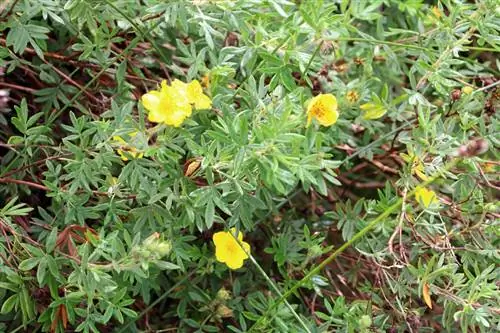
Cutting
The natural growth of the five-finger bush is more width than height. The Potentilla fruticosa is cut in spring or immediately after flowering - by a third. Cutting back to 2/3 of the plant prevents the plant from balding from below. As a typical summer bloomer, the five-fingered bush shows its flowers on this year's formed (“new”) wood. In principle, pruning about every 2 to 3 years is sufficient. If necessary, such as after a pest infestation, you can cut back more heavily. However, the drastic rejuvenation cut should not go too deep into the old wood, as weak or over-aged bushes can die.
Propagate
The five-fingered bush can be easily propagated by cuttings that are cut from existing plants in summer. These are placed in a mixture of garden soil and sand and kept only slightly moist for the following period. Propagation by seeds is also possible. To do this, the seeds are collected from a bush in autumn and sown directly at the desired location in the garden.
Diseases
The five-finger bush has little to fear from diseases, although powdery mildew can be expected under certain circumstances. The wild forms of Potentilla fruticosa are even more resilient than the yellow and white plants. If the pH value of the substrate is too high, this can lead to an iron deficiency (iron chlorosis) in the plant, with too much fertilizer having a negative impact on flower formation.
Pests
Aphids can occasionally appear and can be controlled using commercially available pest infestation products.
Editor’s Tip
With its small size, the five-fingered shrub is not only suitable for planting in containers, but also looks very good, individually or in groups, in small gardens, as a ground cover, for planting on slopes or as a grave and bed border. In Japanese, formal and modern gardens, the Potentilla fruticosa looks particularly attractive after a topiary. This plant reacts somewhat sensitively to very calcareous soil, and its leaves quickly develop unsightly spots or turn yellow. To prevent this, it is best to water the shrub only with rainwater.
Frequently asked questions
How to cut the five-finger bush?
Pruning 1/3 of the plant every two to three years is sufficient.
Is the five-finger bush evergreen?
The shrub sheds its leaves in winter, but is absolutely hardy.
What you should know about the five-fingered bush in brief
- The five-finger bush (Potentilla fruticosa) is an extremely easy-care plant that blooms over a long period of time.
- This small shrub comes in different varieties that produce yellow, red, white or pink flowers.
- Depending on the variety, the flowering period begins in spring or early summer and lasts until autumn.
- Some of these varieties are very suitable as ground cover, others are more suitable as a small bush or as a hedge plant.
- The five-finger bush usually grows to a height of around 50 to 70 cm and grows quite bushy.
- It can be placed individually or in a group
- and is also suitable as a low hedge that can be kept at the desired height through regular trimming.
Varieties such as the Potentilla fruticosa Gold Carpet, which grows widely and thus protects large areas from weeds, are suitable as ground cover. In order for it to form a closed carpet, around five plants are needed per square meter. The Potentilla fruticosa Gold Carpet blooms from May to October with numerous yellow flowers that stand out against the green of the foliage.
- The five-finger bush should be given a sunny to semi-shady place where it doesn't get too hot in summer.
- If necessary, it can be shaded by larger trees.
- After the plant has grown well, it usually no longer needs to be watered because it needs little water.
- For this reason, the five-finger bush is also very suitable as a rock garden plant or for other rather dry places in the garden.
- However, the soil should not be too dry, so the five-finger bush should be watered every now and then in summer during long dry periods.

